Power Supply Design and Distribution
|
|
|
|
Boris Sasic
KEPCO, Inc., Engineering Dept.
Abstract: This paper deals with a power factor correction circuit based on the isolated boost
converter. An additional circuit provides zero-voltage-transition (ZVT) switching while
maintaining constant frequency operation. A transformer used to provide galvanic isolation
enables a wide range of output voltages, either lower or higher than the input voltage, allowing
multi-output solutions. By optimizing the transformer turns ratio, output voltage(s) can be
adjusted to optimum value for any postregulator circuit (e.g., buck or buck-boost). This means
that very high overall efficiency can be achieved with excellent regulation and fast response.
After a brief analysis of the isolated ZVT boost converter and the two-output version, one way
to optimize transformer turns ratio and a solution for control circuitry are proposed. Finally,
advantages and disadvantages are discussed, and possible applications as a single converter,
without postregulators, are also considered.
|
|
Copyright © 2001 IEEE. Reprinted from IEEE Instrumentation and Measurement magazine, December 2000.
This material is posted here with permission of the IEEE. Such
permission of the IEEE does not in any way imply IEEE endorsement of any
of Kepco's products or services. Internal or personal use of this
material is permitted. However, permission to reprint/republish this
material for advertising or promotional purposes or for creating new
collective works for resale or redistribution must be obtained from the
IEEE by sending a blank email message to pubs-permissions@ieee.org.
By choosing to view this document, you agree to all provisions of
the copyright laws protecting it.
|
Power Supply Design and Distribution
by Kim Fowler
I think about system concerns and interactions when designing instrumentation. One issue often overlooked is power regulation and distribution. I discuss some of the concepts involved in designing power systems for instrumentation. At the end of the column, I present a case study for powering a data acquisition system on a submarine.
Methodology
Early in the development of an instrument, you should consider the power regulation and distribution. Too often, the project team pushes off the design until it is too late. Then you are stuck with trying to "shoe-horn" the power subsystem into a tiny space with little time to do it. The power design affects many things including electromagnetic compliance, weight, size, and heat dissipation.
A proper approach considers the instrument as a system with many interacting components and constraints. The power subsystem is just one of the components. Here are the major steps in designing the power regulation and distribution:
- Define the source of power and understand its actual condition
- Determine the needs and constraints of the system
- Understand the types of converters
- Select the method of distribution
If you use the AC mains for input power in your instrument, you need to know the reliability of service. Many AC lines suffer from dropout, surge, over voltage, spiking, and low voltage. You should filter the input power to survive some of these anomalous conditions. Governmental regulations may require power factor correction and electromagnetic compliance. Moreover, you may want to provide battery backup, such as an uninterruptible power supply, to maintain robust operation.
If your power source is DC, such as batteries or solar panels, you have another set of constraints and environmental conditions. As John Witzel points out in this issue of My Favorite Experiment column, batteries require special consideration in charging and discharging. (Honestly, John and I did not collude in preparing our columns!)
Power conversion
Once you establish the input power, select the type of power regulation and distribution that is most suitable. In general, power supplies have four major components or subsystems: AC-to-DC conversion, filtering, regulator, and output filtering. Figure 1 illustrates the general configuration for power regulation. Distribution of power usually occurs at one of three points in Figure 1, at the front end with AC power, immediately after the AC-to-DC conversion with raw DC power, or after the output filter stage with filtered DC power.

| Fig. 1. The general configuration for power conversion. (© 1996, Oxford University Press, Inc. Used with permission.) |
Once you understand the basics of regulation, select the regulator. The types of regulator that can be used are:
- Linear regulation where a pass transistor controls voltage and reduces ripple
- Switching regulation that uses transistors as switches to generate high frequency modulation
- Ferroresonant regulation where a constant voltage transformer controls voltage and reduces ripple
The constant voltage transformer in ferroresonant regulation is large and heavy and usually constrains it to ground installations for uninterruptible power supplies. Typically, most applications incorporate either a linear regulator or a switching power supply.
Linear converters
Linear regulation uses a pass transistor as the control element to remove or reduce ripple in the output DC power. Figure 2 shows the general configuration for a linear power supply.

| Fig. 2. (a) The general configuration for a linear power converter. It uses a pass transistor as a variable resistor to reduce or remove ripples in the filter output. (b) The regulator, in more detail, that controls the pass transistor. (© 1996, Oxford University Press, Inc. Used with permission.)
|
Linear power supplies are simple and inexpensive. They provide excellent line regulation and transient response to changes in load. They tend, however, to be bulky and heavy because poor efficiency (< 40%) limits their power density (< 0.12 W/cm3 or 2 W/in3).
Linear regulation and power supplies fit best in low-power situations that demand very "clean" power.
Switching converters
Switching regulation generates high frequency modulation to transform the voltage and filter the ripple in the output DC power. Figure 3 shows some general configurations for switching power supplies.

| Fig. 3. Some general configurations for switching power converters. They use switching transistors to modulate the input to the transformer and output filter to reduce ripples in the filter output. (a) Flyback-mode regulation. (b) Forward-mode regulation. (c) Half-bridge regulation. (d) Full-bridge regulation. (© 1996, Oxford University Press, Inc. Used with permission.)
|
Switching power supplies can have excellent efficiency (> 95%) and high power density (> 6 W/cm3 or 100 W/in3). They can accept wide variation of input voltage (> 100%) and frequency (> 100%) and generally have good line regulation and transient response. They can be very small and light. Switching power supplies tend, however, to be more complex and expensive than linear supplies and power factor correction must be added in many applications.
Switching power supplies fit best in situations that require efficient power conversion.
Power distribution
Power may be distributed in several ways. One configuration is the centralized supply that delivers filtered DC power via power conductors and power planes to circuits, sensors, and actuators. Another configuration is the distributed supply that delivers raw, unfiltered DC power to local regulation units. Figure 4 illustrates a centralized supply; Figure 5 shows a distributed supply.
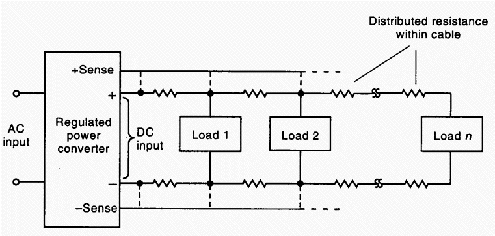
| Fig. 4. Power distribution from centralized power regulation. (© 1996, Oxford University Press, Inc. Used with permission.)
|
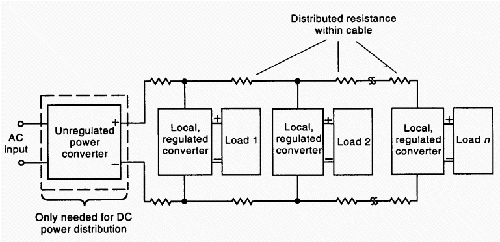
| Fig. 5. Power distribution with distributed regulation. (© 1996, Oxford University Press, Inc. Used with permission.)
|
Centralized distribution may use either a linear or switching power supply. Typically, it delivers low voltage, sometimes at moderate amounts of current. It is simple in concept and relies on low-impedance conductors to distribute the current the circuits and components. Centralized distribution is best suited for small, localized systems; these range from small handheld devices and personal computers to 21-slot backplanes in equipment chassis.
Distributed systems have multiple points of power conversion. They distribute higher voltages at lower currents, than centralized supplies, to local power converters, which usually are switching power supplies. They do not need heavy, expensive conductors. Distributed systems are best suited for big systems such as large equipment racks, aircraft, and ships.
Distributed systems tend to be more robust than centralized supplies because they can isolate failure. If designed carefully, they can be simpler to maintain and repair, as well. "Telecom applications demand high reliability with N+1 redundant power supplies that are hot swappable for fast replacement in the event of a power-supply failure." [1] Table 1 gives a comparison of distributed and centralized supplies.
| Table 1. Centralized versus distributed power regulation. (© 1996, Oxford University Press, Inc. Used with permission.)
|
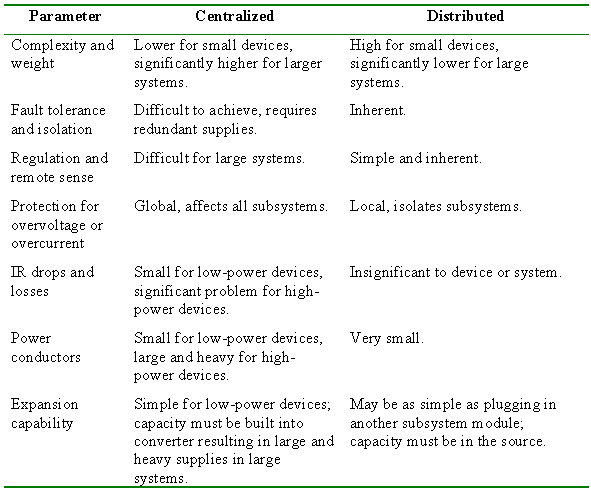
Buy vs. build
This usually is not even a question - buy the power supply. Only in the extreme situations, where either you are squeezing pennies from the mass-production of thousands or millions of units or the application has incredibly harsh requirements (e.g. a satellite), do you design the power supply. Even then, you should have a specialist, such as a consultant or an applications engineer from a qualified power supply vendor, onboard to help you.
A friend of mine, whose company manufactures equipment chassis, has an ongoing headache with power supplies. First, the custom-designed unit failed miserably, then the purchased unit from a reputable vendor demonstrated poor reliability. Only by working with the vendor on each application has he been able to avert problems.
Commercial power supplies tend to be more reliable, robust, and smaller than custom designs. The commercial vendors can build on economy of scale in manufacturing and years of experience and expertise to build better supplies. In the telecom example, equipment designers are using commercial supplies, ". . . today's trend is toward plug-in power-supply modules, which are easily accessible and serviceable . . ." [2]
In the early 1980s, the U.S. Navy found that power supplies caused a disproportionate number of equipment failures. Most of these were custom-designed supplies. In later years, reliable supplies built to military standards by commercial vendors have greatly reduce the failure rate. This example does not mean that commercial supplies are a panacea, but rather that you should find a reputable source of both power supplies and help to use them.
Submarine data acquisition system
Years ago, I designed a data acquisition system for an experiment onboard a submarine. It had sensors spread out along the outer hull (Figure 6). [3] The sensors each had high-speed analog circuitry and a high-resolution, analog-to-digital converter (ADC). These circuits needed ripple-free DC power. Furthermore, project management mandated that power distribution to the sensors would be low-voltage DC power. The power supply and distribution required careful consideration during design and manufacturing.
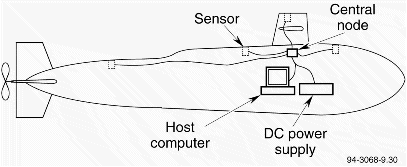
| Fig. 6. Power distribution for a submarine data acquisition system. (© 1996, Oxford University Press, Inc. Used with permission.) |
The cables that connected the sensors had a fixed number of conductors. Most of the conductors were devoted to data transmission, leaving only four wires for power supply. The wires were 22-gauge copper, which have considerable resistance (16 W/1000 ft or 52 W/1000 m). For a cable run of 50 m each wire had a resistance of 2.6 W; summing the + and return lines, this resistance totaled 5.2 W. By doubling up the wire pairs, the total resistance was cut in half to 2.6 W. One amp of current passing through the wires would then reduce the voltage by 2.6 V at the sensor.
I had to decide between linear and switching regulation in each sensor by considering that the16-bit ADCs had a resolution of 610 microvolts. A linear regulator could achieve this kind of noise floor easily, but, with less than 40 % efficiency, it would more than double both the current and voltage drop in each cable. This would seriously affect the low-voltage DC power supply sourcing the current. Therefore, I chose a switching power module for efficient, local regulation in each sensor to maintain adequate power margins. The tradeoff was that a custom filter had to be added to the output of the switching regulator to reduce noise and ripple.
Unfortunately, switching power supplies have nonlinear transfer functions (Figure 7). As current demand varied in each sensor, it changed the voltage drop in the cables. This would change its efficiency, which directly affected power consumption and heat dissipation. Consequently, I had to simulate the various possible operations extensively to estimate sufficient margin for operating the system. Then we had to test the actual hardware for the entire system to verify the results of the simulations (Figure 8).
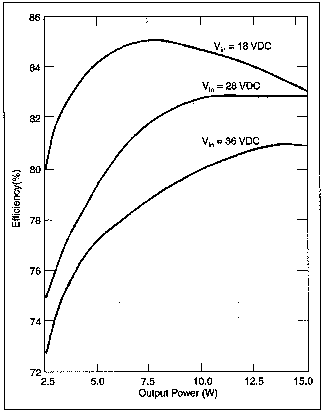 |  |
| Fig. 7. Efficiency varies with both input voltage and output power. (© 1996, Oxford University Press, Inc. Used with permission.) | Fig. 8. Actual, measured power consumption is shown to be a nonlinear function of voltage and current variations within the distributed power system. (© 1996, Oxford University Press, Inc. Used with permission.) |
The upshot is that whenever you develop a system be sure to conceive, design, and test it carefully. Plan for each of these phases early in development.
Recommended Reading
For general introduction to power supplies, I recommend several books. They are:
- J. D. Shepard, Power Supplies, Reston, VA: Reston Publishing, 1984.
- I. Pressman, Switching Power Supply Design, New York: McGraw-Hill, 1991.
What's Next?
Next, I plan to cover heat dissipation and cooling concerns in instrumentation. I welcome your ideas, comments, and critique. My e-mail address is kfowler@stimsoft.com.
Biography
Kim is Vice President, Systems Development at Stimsoft, Inc. where he develops concepts for new medical electronic products. He has written a textbook, Electronic Instrument Design: Architecting for the Life Cycle, published by Oxford University Press that provides the background for much of the material in this column.
References
- [1] E. Eacueo, "What Should You Look For When Specifying An Electronics Enclosure?" Electronic Design, June 14, 1999, p. 68.
- [2] Ibid.
- [3] K. R. Fowler, Electronic Instrument Design, Oxford University Press, New York, 1996, pp. 357-362.











